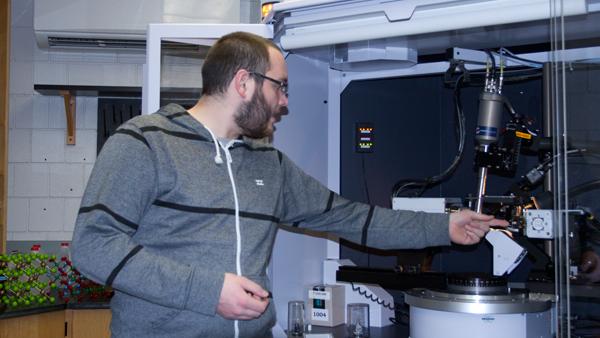Ithaca College chemistry students now have a unique opportunity to gain experience identifying molecules and chemical compounds using X-ray diffraction — thanks to the department’s newly acquired single-crystal X-ray diffractometer.
The college’s chemistry department set up the new measuring instrument last semester, making the college one of the few chemistry programs in the country that uses the machine for undergraduate-level research.
Undergraduate research students produce compounds that have unconfirmed identities on a daily basis. Single-crystal X-ray diffraction is a non-destructive analytical technique, which gives data about the spacing between atoms in crystalline substances, thereby helping researchers recognize these substances.
The machine is currently used by about 20 undergraduate students. The instrument will also be used in select chemistry courses, such as Experimental Chemistry IV.
The diffractometer cost the college $220,000 and was covered by the college budget.
Vince DeTuri, chair of the chemistry department, said the new diffractometer provides students with valuable hands-on experience.
“You learn chemistry by doing chemistry,” DeTuri said. “We can talk about X-ray diffraction and crystal structure and do a great job of that, but there is something really special and really unique about learning it in the classroom and then going to a lab and then doing it yourself.”
DeTuri also said working on the machine gives students an edge when going in for graduate studies.
“It’s just going to be a phenomenal educational tool,” he said. “Graduate programs use X-ray diffractometers, so students going on to graduate programs will now have this rich experience and be ahead of other graduate students.”
Before the college purchased the diffractometer, samples that needed to be identified using X-ray crystallography were sent to Cornell University.
Senior Shane Galley, a chemistry major who is also a part of the research program, said the new instrument means students will be required to spend less time waiting for results of identification tests.
“We’d have to wait two three weeks for them and that was no fun,” he said. “But now, with this machine within our own building, we can do it overnight.”
Single-crystal X-ray diffraction has not been widely incorporated into undergraduate science curricula across the country, according to a 2005 article in the Journal of Chemical Education published by the American Chemical Society.
The article said the budgets of primarily undergraduate institutions like the college tend to “struggle to fund instruments that are widely considered essential.”
Each year, departments in the college’s School of Humanities and Sciences submit a list of their needs. The school then prioritizes these needs before sending them to the provost for approval.
Leslie Lewis, dean of the School of Humanities and Sciences, said the school typically gets hundreds of thousands of dollars in capital equipment. She said the School of Humanities and Sciences prioritizes initiatives that benefit students.
“We try to prioritize where we think we will provide the most opportunity for students working with faculty,” she said. “In particular, we are talking about undergraduate research.”
Lewis said undergraduate research is an important part of the preparation for what comes after graduation.
“We are also setting the stage for students [to] understand what it means to produce new knowledge, and that’s what research is all about,” she said. “That’s a very important part of our culture and society.”
Senior Josh Page, a chemistry major, has been a part of the college’s undergraduate research program since Fall 2011. He works with Janet Hunting, assistant professor of chemistry, to investigate metal oxides and the creation of new materials without going through a liquid phase.
After his graduation in May 2013, Page will be attending Colorado State University for a Ph.D. in Inorganic Materials Chemistry. He said the experience of having used the diffractometer put him at an advantage.
“It’s a fairly complicated instrument,” Page said. “Just knowing how to use it and having experience on that is good, because it means the professors trust you enough with an expensive machine.”
his semester, the chemistry department offered a Block I class, which covered the basics of the diffractometer and allowed students to practice using the instrument. DeTuri said the course, which was an advanced elective, was over capacity.
Galley was one of the 12 students who took the course, which was titled Introduction to X-Ray Crystallography.
Galley is a part of the chemistry research program led by Anna Larsen, associate professor of chemistry. Galley said he expects the precision of the instrument will help him with his future research.
Galley’s class schedule requires that he spend 12 to 15 hours a week doing lab work, but during a typical week, he said he spends 20 to 25 hours in the lab.
“I am all about the research,” he said. “I love being in the lab.”
Page’s favorite part of the research experience has been the connections he has made.
“You end up becoming really close knit,” he said. “You communicate well with your professors … and it’s also a learning experience. It’s hands-on.”








